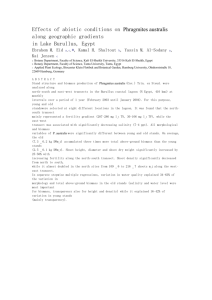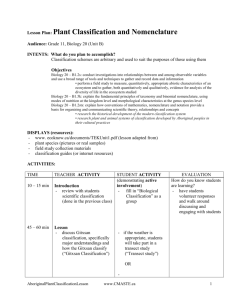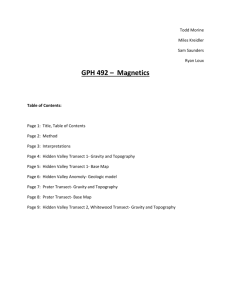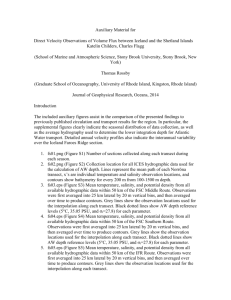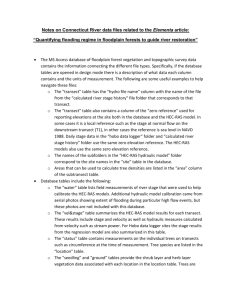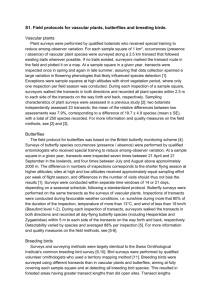Line Transect Basics
advertisement
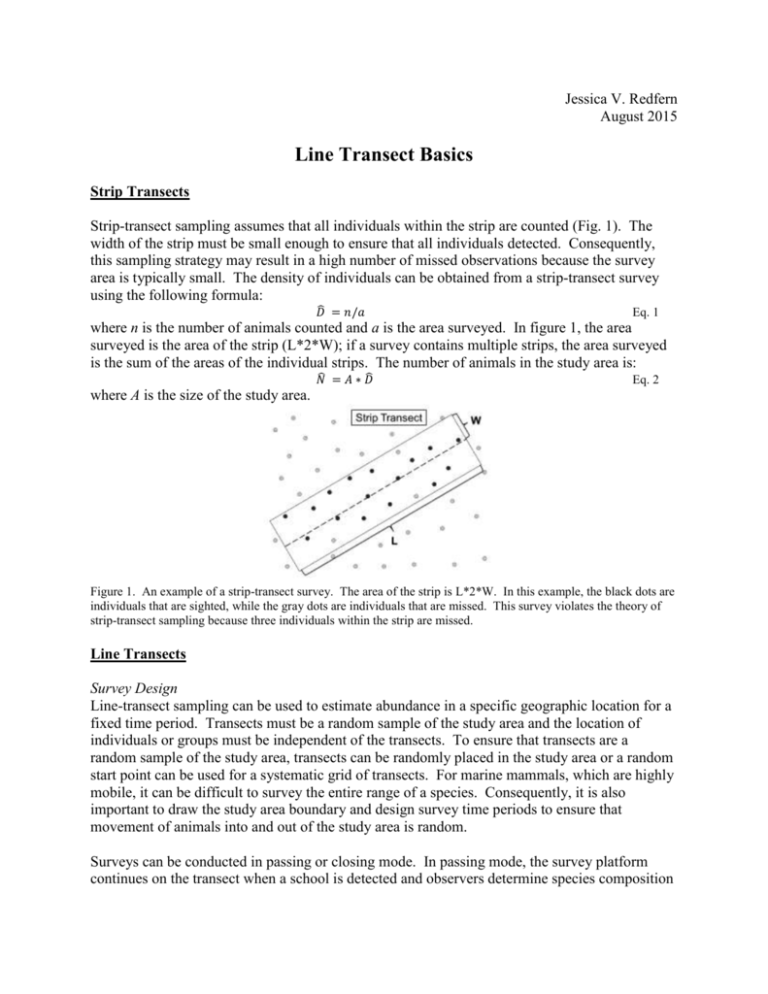
Jessica V. Redfern August 2015 Line Transect Basics Strip Transects Strip-transect sampling assumes that all individuals within the strip are counted (Fig. 1). The width of the strip must be small enough to ensure that all individuals detected. Consequently, this sampling strategy may result in a high number of missed observations because the survey area is typically small. The density of individuals can be obtained from a strip-transect survey using the following formula: ̂ = 𝑛/𝑎 𝐷 Eq. 1 where n is the number of animals counted and a is the area surveyed. In figure 1, the area surveyed is the area of the strip (L*2*W); if a survey contains multiple strips, the area surveyed is the sum of the areas of the individual strips. The number of animals in the study area is: ̂ =𝐴∗𝐷 ̂ 𝑁 Eq. 2 where A is the size of the study area. Figure 1. An example of a strip-transect survey. The area of the strip is L*2*W. In this example, the black dots are individuals that are sighted, while the gray dots are individuals that are missed. This survey violates the theory of strip-transect sampling because three individuals within the strip are missed. Line Transects Survey Design Line-transect sampling can be used to estimate abundance in a specific geographic location for a fixed time period. Transects must be a random sample of the study area and the location of individuals or groups must be independent of the transects. To ensure that transects are a random sample of the study area, transects can be randomly placed in the study area or a random start point can be used for a systematic grid of transects. For marine mammals, which are highly mobile, it can be difficult to survey the entire range of a species. Consequently, it is also important to draw the study area boundary and design survey time periods to ensure that movement of animals into and out of the study area is random. Surveys can be conducted in passing or closing mode. In passing mode, the survey platform continues on the transect when a school is detected and observers determine species composition and group size from the transect. In closing mode, normal survey protocols are stopped after a school is sighted (e.g., observers go off effort) and the survey platform approaches the school. Experiments have shown that species identification and group size estimation are improved on closing mode surveys. However, encounter rates may be underestimated on closing mode surveys. A more detailed discussion of an experiment to assess differences between passing and closing modes on a cetacean and ecosystem assessment survey conducted by the Southwest Fisheries Science Center in the eastern tropical Pacific can be found in Schwarz, L. K., T. Gerrodette, and F. I. Archer. 2010. Comparison of closing and passing mode from a line-transect survey of delphinids in the eastern Tropical Pacific Ocean. J. Cetacean Res. Manag 11:253-265. While there are benefits and costs to surveying in each mode, the Southwest Fisheries Science Center uses closing mode because the benefits outweigh the costs for these surveys. For details about protocols that can be used on closing mode surveys, see the document that describes the marine mammal data collection procedures used by NOAA Fisheries’ Southwest Fisheries Science Center. When the Southwest Fisheries Science Center conducted an experiment in the eastern tropical Pacific to assess the trade-offs between passing and closing mode surveys, the following protocols were used for passing mode. The ship traveled at a constant speed of 18.52km/hr (10knots). Only the observer that made the sighting identified the species and estimated group size. The other observers continued to search their areas of responsibility. Effort for the observer making a sighting was not continuous because the observer had to stop searching to obtain information about the sighting. Alternative approaches to surveying in passing mode have been used by other groups. For example, on Antarctic minke whale surveys, one group of observers searches for animals while a second group is responsible for identifying the species and estimating group size. Passing mode has also been used for over 10 years to survey for marine mammals on quarterly oceanographic surveys conducted off Southern California. On these surveys, observers search for animals using unaided eye or 7x50 power binoculars. Ship speed can vary on these surveys; consequently, observers are only considered on effort when the ship is traveling at 11km/hr or faster. Observers scan from 90˚ abeam to 10˚ past the transect on the opposite of the vessel. Species identifications and group size estimates are generally made by the lead observer, but are agreed on by all observers. Binoculars with a higher power (i.e., 25x150 or 18x50) are used on these surveys to aid in identifying species and obtaining group size estimates. If using passing mode, choose a methodology that maximizes the possibility of identifying species and obtaining accurate group size estimates. You can also alternate between passing and closing mode on a single survey. In this case, it is important to specify which mode is being used. General Theory Line-transect sampling assumes that all schools on the transect are detected and that the distance to each school is accurately estimated (Fig. 2). It is particularly important that the distance to the school is not altered by the survey platform (e.g., the school does not approach or avoid a ship before it is detected and the distance is estimated). The distance to each school is used to estimate an effective strip width. Figure 2. An example of line-transect sampling. The area surveyed is estimated using the perpendicular distance to each sighting. Line transect sampling assumes that all individuals on the transect are sighted and that the perpendicular distance to each sighting is accurately estimated. In this example, the black dots are schools that are sighted, while the gray dots are schools that are missed. The perpendicular distance from the transect (e.g., ship’s course) to a school is calculated using the following formula: 𝑑 = 𝑟 sin 𝜃 Eq. 3 where 𝑟 is the radial distance to the sighting and 𝜃 is the angle to the sighting (Fig 3). The angle to the school can be estimated by eye or by using a horizontal angle board. The radial distance (i.e., shortest straight line distance) to the school can be estimated by eye or using a reticle scale. The reticle scale is a series of equally spaced horizontal lines that are inscribed on binocular eye pieces. To measure the distance to an animal in the water, the upper most reticle is placed at the horizon and the number of reticles to the animal is counted. The radial distance to a sighting can be calculated using the following formula: 𝑟 = (𝑒 + ℎ) ∗ sin(𝛼 + 𝜌𝐶) − √𝑒 2 − [(𝑒 + ℎ) ∗ cos(𝛼 + 𝜌𝐶)]2 Eq. 4 where e is the radius of the earth in kilometers (6371km), h is the binocular height above the sea surface in kilometers, 𝜌 is reticle reading (number of reticles from the horizon to the animal), C is the reticle conversion factor in radians, and α is atan(H/e). The variable H is the distance to the horizon and can be estimated using the following formual: 𝐻 = √2 ∗ 𝑒 ∗ ℎ + ℎ2 Eq. 5 The reticle conversion factor for the Fujinon 7x50 power FMT series binoculars is estimated to be 0.279. To convert degrees per reticle to radians per reticle, multiply by π/180. Figure 3. The radial distance, 𝑟, and angle, 𝜃, to each school are recorded in line-transect sampling and used to calculate the perpendicular distance from the transect to the school (see Equation 3). Line-transect sampling assumes that detections of schools decrease in some smooth fashion as the distance from transect increases. A histogram of number of schools detected at different perpendicular distances from the transect (Fig. 4a) is rescaled so that the area of the bars in the histogram sums to one and the detection function is fit to the rescaled data (Fig. 4b). The effective strip width (ESW) is estimated as the point at which the number of schools detected beyond the ESW is equal to the number of schools that are missed within the ESW (i.e., the shaded areas within and beyond the ESW in Figure 4c are equal). a) b) c) Figure 4. Estimating the effective strip width in line-transect sampling. a) A histogram of the number of schools detected at different perpendicular distances from the transect b) The histogram is rescaled so that the area of the bars in the histogram sums to one and a detection function is fit. c) The effective strip width (ESW) is the distance at which the area above the curve (number of schools missed within the ESW) is equal to the area below the curve (number of schools detected beyond ESW). The density of schools can then be estimated using the same formula as is used for strip transects (equations 1), but the ESW replaces the strip width: 𝑛 ̂ = 𝐷𝑠𝑐ℎ𝑜𝑜𝑙𝑠 Eq. 6 (𝑙∗2∗𝐸𝑆𝑊) where n is the number of schools counted and l is the length of the transect. To estimate the number of animals, we need to multiple by the mean group size: ̂ ̂ = 𝑛∗𝐸(𝑠) 𝐷𝑎𝑛𝑖𝑚𝑎𝑙𝑠 Eq. 7 (𝑙∗2∗𝐸𝑆𝑊) where 𝐸̂ (𝑠) is the mean group size. Figures 5 and 6 illustrate histograms of perpendicular distances from the transect that indicate a problem in the data collection. For example, the shape of the histogram in figure 5 could result from animals moving away from a ship before being detected or inadequate views of the transect in an aerial survey. The shape of the histogram in figure 6 could result from animals moving toward a ship (e.g., bow riders) before being detected, observers rounding to zero for animals close to the transect, or observers searching the transect more than other areas. It is difficult to fit a detection function to these histograms – many shapes are possible for the detection function and each shape results in a different estimate of abundance. Fixing these problems can be complicated. As a starting point, it is critical to ensure that each observer systematically scans their entire area and that animals are detected as early as possible. There are numerous methods for fitting the detection function. For information on the next steps for analyzing line-transect data, please visit http://distancesampling.org/. This website contains many valuable resources including the free software to estimate abundance, information on joining a line-transect analysis list serve, a bibliography, and information on training courses in estimating abundance from line-transect data. For a good introduction to line-transect theory, you can read Buckland, S. T., D. R. Anderson, K. P. Burnham, J. L. Laake, D. L. Borchers, and L. Thomas. 2001. Introduction to Distance Sampling: Estimating abundance of biological populations. Oxford University Press, Oxford. These next steps are beyond the scope of our current workshop and this document, which focus on collecting the best possible data to estimate the abundance of marine mammals. It is hoped that this introduction to line-transect theory has emphasized: the importance of ensuring all animals on the transect are seen distance to schools is accurately estimated the detection function has a shoulder the importance of accurately estimating group size. Figure 5. If animals on the transect are missed or animals move away from the survey platform before they are detected, many different shapes are possible for the detection function. These different shapes result in different estimates of animal abundance. Figure 6. If the number of schools detected drops quickly after some initial distance close to the transect (the detection function does not have a shoulder), the shape of the detection function could range from exponential to having a shoulder at these close distances. These different shapes result in different estimates of animal abundance.

